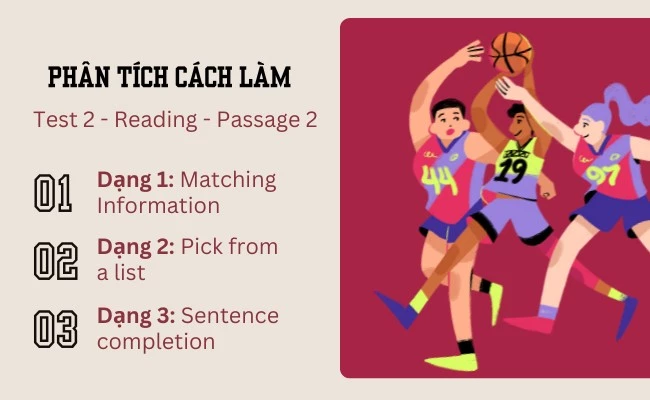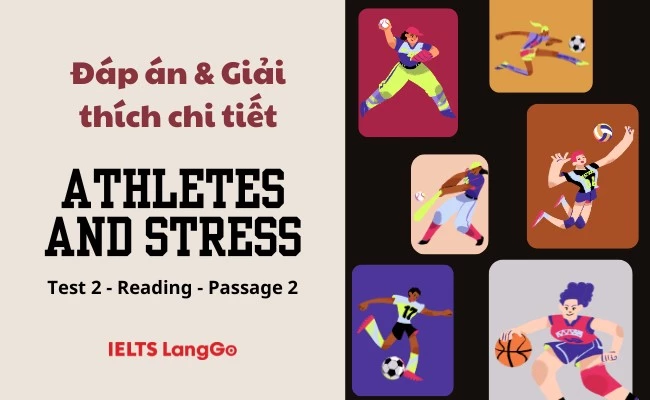


Trong bài viết này, IELTS LangGo sẽ cung cấp cho các bạn đáp án và giải thích chi tiết của bài IELTS Reading Athletes and stress trong bộ đề Cam 19: Test 2, Reading passage 2, cũng như bảng từ vựng hữu ích để chúng mình luyện đề một cách hiệu quả hơn nhé!
Athletes and stress
A.
It isn’t easy being a professional athlete. Not only are the physical demands greater than most people could handle, athletes also face intense psychological pressure during competition. This is something that British tennis player Emma Raducanu wrote about on social media following her withdrawal from the 2021 Wimbledon tournament. Though the young player had been doing well in the tournament, she began having difficulty regulating her breathing and heart rate during a match, which she later attributed to ’the accumulation of the excitement and the buzz’.
Trở thành một vận động viên chuyên nghiệp không phải là điều dễ dàng. Không chỉ có yêu cầu về thể chất lớn hơn người bình thường, các vận động viên còn phải đối mặt với áp lực tâm lý dữ dội trong quá trình thi đấu. Đây là điều mà tay vợt người Anh Emma Raducanu đã viết trên mạng xã hội sau khi cô rút lui khỏi giải đấu Wimbledon 2021. Mặc dù tay vợt trẻ này đã chơi tốt trong giải đấu, cô bắt đầu gặp khó khăn trong việc điều chỉnh nhịp thở và nhịp tim trong một trận đấu, điều mà sau đó cô cho là do "sự tích tụ của sự vui mừng và phấn khích".
B.
For athletes, some level of performance stress is almost unavoidable. But there are many different factors that dictate just how people’s minds and bodies respond to stressful events. Typically, stress is the result of an exchange between two factors: demands and resources. An athlete may feel stressed about an event if they feel the demands on them are greater than they can handle. These demands include the high level of physical and mental effort required to succeed, and also the athlete’s concerns about the difficulty of the event, their chance of succeeding, and any potential dangers such as injury. Resources, on the other hand, are a person’s ability to cope with these demands. These include factors such as the competitor’s degree of confidence, how much they believe they can control the situation’s outcome, and whether they’re looking forward to the event or not.
Đối với các vận động viên, một số mức độ căng thẳng khi thi đấu gần như là không thể tránh khỏi. Nhưng có nhiều yếu tố khác nhau quyết định cách tâm trí và cơ thể của mọi người phản ứng với các sự kiện căng thẳng. Thông thường, căng thẳng là kết quả của sự trao đổi giữa hai yếu tố: sự đòi hỏi và nguồn lực. Một vận động viên có thể cảm thấy căng thẳng về một sự kiện nếu họ cảm thấy những yêu cầu đối với họ lớn hơn khả năng xử lý của họ. Những yêu cầu này bao gồm mức độ nỗ lực về thể chất và tinh thần cao cần thiết để thành công, cũng như mối quan tâm của vận động viên về độ khó của sự kiện, cơ hội thành công của họ và bất kỳ mối nguy hiểm tiềm ẩn nào như chấn thương. Mặt khác, nguồn lực là khả năng của một người để đối phó với những yêu cầu này. Chúng bao gồm các yếu tố như mức độ tự tin của đối thủ, mức độ họ tin rằng họ có thể kiểm soát kết quả của tình huống và liệu họ có mong chờ sự kiện đó hay không.
C.
Each new demand or change in circumstances affects whether a person responds positively or negatively to stress. Typically, the more resources a person feels they have in handling the situation, the more positive their stress response. This positive stress response is called a challenge state. But should the person feel there are too many demands placed on them, the more likely they are to experience a negative stress response - known as a threat state. Research shows that the challenge states lead to good performance, while threat states lead to poorer performance. So, in Emma Raducanu’s case, a much larger audience, higher expectations and facing a more skilful opponent, may all have led her to feel there were greater demands being placed on her at Wimbledon -but she didn’t have the resources to tackle them. This led to her experiencing a threat response.
Mỗi yêu cầu mới hoặc thay đổi trong từng hoàn cảnh đều ảnh hưởng đến việc một người phản ứng tích cực hay tiêu cực với căng thẳng. Thông thường, một người cảm thấy mình có càng nhiều nguồn lực để xử lý tình huống thì phản ứng căng thẳng của họ càng tích cực. Phản ứng căng thẳng theo hướng tích cực này được gọi là trạng thái thách thức. Nhưng nếu một người cảm thấy có quá nhiều yêu cầu được đặt ra cho họ, thì họ càng có nhiều khả năng trải qua phản ứng căng thẳng tiêu cực - được gọi là trạng thái đe dọa. Nghiên cứu cho thấy trạng thái thách thức dẫn đến hiệu suất tốt, trong khi trạng thái đe dọa dẫn đến hiệu suất kém hơn. Vì vậy, trong trường hợp của Emma Raducanu, lượng khán giả lớn hơn nhiều, kỳ vọng cao hơn và đối mặt với đối thủ khéo léo hơn, tất cả có thể khiến cô cảm thấy có nhiều yêu cầu hơn được đặt ra cho mình tại Wimbledon - nhưng cô không có nguồn lực để giải quyết chúng. Điều này dẫn đến việc cô trải qua phản ứng đe dọa.
D.
Our challenge and threat responses essentially influence how our body responds to stressful situations, as both affect the production of adrenaline and cortisol - also known as ‘stress hormones’. During a challenge state, adrenaline increases the amount of blood pumped from the heart and expands the blood vessels, which allows more energy to be delivered to the muscles and brain. This increase of blood and decrease of pressure in the blood vessels has been consistently related to superior sport performance in everything from cricket batting, to golf putting and football penalty taking. But during a threat state, cortisol inhibits the positive effect of adrenaline, resulting in tighter blood vessels, higher blood pressure, slower psychological responses, and a faster heart rate. In short, a threat state makes people more anxious -they make worse decisions and perform more poorly. In tennis players, cortisol has been associated with more unsuccessful serves and greater anxiety.
Phản ứng thách thức và đe dọa của chúng ta về cơ bản ảnh hưởng đến cách cơ thể chúng ta phản ứng với các tình huống căng thẳng, vì cả hai đều ảnh hưởng đến việc sản xuất adrenaline và cortisol - còn được gọi là 'hormone căng thẳng'. Trong trạng thái thách thức, adrenaline làm tăng lượng máu được bơm từ tim và mở rộng các mạch máu, cho phép nhiều năng lượng hơn được cung cấp cho các cơ và não. Sự gia tăng máu và giảm áp lực trong các mạch máu này luôn liên quan đến hiệu suất thể thao vượt trội trong mọi thứ, từ đánh bóng cricket, đến đánh bóng gôn và phạt đền trong bóng đá. Nhưng trong trạng thái đe dọa, cortisol ức chế tác dụng tích cực của adrenaline, dẫn đến mạch máu thắt chặt hơn, huyết áp cao hơn, phản ứng tâm lý chậm hơn và nhịp tim nhanh hơn. Tóm lại, trạng thái đe dọa khiến mọi người lo lắng hơn - họ đưa ra quyết định tồi tệ hơn và chơi kém hơn. Ở những người chơi quần vợt, cortisol có liên quan đến nhiều cú giao bóng không thành công hơn và lo lắng hơn.
E.
That said, anxiety is also a common experience for athletes when they’re under pressure. Anxiety can increase heart rate and perspiration, cause heart palpitations, muscle tremors and shortness of breath, as well as headaches, nausea, stomach pain, weakness and a desire to escape in more extreme cases. Anxiety can also reduce concentration and self-control and cause overthinking. The intensity with which a person experiences anxiety depends on the demands and resources they have. Anxiety may also manifest itself in the form of excitement or nervousness depending on the stress response. Negative stress responses can be damaging to both physical and mental health -and repeated episodes of anxiety coupled with negative responses can increase risk of heart disease and depression.
Tuy nhiên, lo lắng cũng là một trải nghiệm phổ biến đối với các vận động viên khi họ chịu áp lực. Lo lắng có thể làm tăng nhịp tim và đổ mồ hôi, gây ra tình trạng tim đập nhanh, run cơ và khó thở, cũng như đau đầu, buồn nôn, đau dạ dày, yếu và trong những trường hợp cực đoan hơn sẽ xuất hiện mong muốn trốn thoát. Lo lắng cũng có thể làm giảm sự tập trung và khả năng tự chủ và gây ra tình trạng suy nghĩ quá mức. Mức độ mà một người trải qua lo lắng phụ thuộc vào nhu cầu và nguồn lực mà họ có. Lo lắng cũng có thể biểu hiện dưới dạng phấn khích hoặc căng thẳng tùy thuộc vào phản ứng căng thẳng. Phản ứng căng thẳng tiêu cực có thể gây hại cho cả sức khỏe thể chất và tinh thần - và các đợt lo lắng lặp đi lặp lại kết hợp với các phản ứng tiêu cực có thể làm tăng nguy cơ mắc bệnh tim và trầm cảm.
F.
But there are many ways athletes can ensure they respond positively under pressure. Positive stress responses can be promoted through the language that they and others – such as coaches or parents – use. Psychologists can also help athletes change how they see their physiological responses – such as helping them see a higher heart rate as excitement, rather than nerves. Developing psychological skills, such as visualisation, can also help decrease physiological responses to threat. Visualisation may involve the athlete recreating a mental picture of a time when they performed well, or picturing themselves doing well in the future. This can help create a feeling of control over the stressful event. Recreating competitive pressure during training can also help athletes learn how to deal with stress. An example of this might be scoring athletes against their peers to create a sense of competition. This would increase the demands which players experience compared to a normal training session, while still allowing them to practise coping with stress.
Nhưng có nhiều cách để các vận động viên có thể đảm bảo họ phản ứng tích cực dưới áp lực. Phản ứng căng thẳng tích cực có thể được thúc đẩy thông qua ngôn ngữ mà họ và những người khác - chẳng hạn như huấn luyện viên hoặc cha mẹ - sử dụng. Các nhà tâm lý học cũng có thể giúp các vận động viên thay đổi cách họ nhìn nhận phản ứng sinh lý của mình - chẳng hạn như giúp họ coi nhịp tim cao hơn là sự phấn khích, thay vì lo lắng. Phát triển các kỹ năng tâm lý, chẳng hạn như hình dung, cũng có thể giúp giảm phản ứng sinh lý đối với mối đe dọa. Hình dung có thể liên quan đến việc vận động viên tái tạo hình ảnh tinh thần về thời điểm họ thể hiện tốt hoặc hình dung bản thân sẽ thể hiện tốt trong tương lai. Điều này có thể giúp tạo ra cảm giác kiểm soát được sự kiện căng thẳng. Tái tạo áp lực cạnh tranh trong quá trình luyện tập cũng có thể giúp các vận động viên học cách đối phó với căng thẳng. Một ví dụ về điều này có thể là chấm điểm các vận động viên so với các đồng nghiệp của họ để tạo ra cảm giác cạnh tranh. Điều này sẽ làm tăng nhu cầu mà người chơi trải qua so với một buổi tập luyện bình thường, đồng thời vẫn cho phép họ thực hành đối phó với căng thẳng.
Questions 14-18
Reading Passage 2 has six paragraphs, A-F.
Which paragraph contains the following information?
Write the correct letter, A-F, in boxes 14-18 on your answer sheet.
NB You may use any letter more than once.
reference to two chemical compounds which impact on performance
examples of strategies for minimising the effects of stress
how a sportsperson accounted for their own experience of stress
study results indicating links between stress responses and performance
mention of people who can influence how athletes perceive their stress responses
Questions 19-22
Complete the sentences below.
Choose ONE WORD ONLY from the passage for each answer.
Write your answers in boxes 19-22 on your answer sheet.
Performance stress involves many demands on the athlete, for example, coping with the possible risk of ……………
Cortisol can cause tennis players to produce fewer good ……………
Psychologists can help athletes to view their physiological responses as the effect of a positive feeling such as ……………
…………… is an example of a psychological technique which can reduce an athlete’s stress responses.
Questions 23 and 24
Choose TWO letters, A-E.
Write the correct letters in boxes 23 and 24 on your answer sheet.
23 -24. Which TWO facts about Emma Raducanu’s withdrawal from the Wimbledon tournamentare mentioned in the text?
the stage at which she dropped out of the tournament
symptoms of her performance stress at the tournament
measures which she had taken to manage her stress levels
aspects of the Wimbledon tournament which increased her stress levels
reactions to her social media posts about her experience at Wimbledon
Questions 25 and 26
Choose TWO letters, A-E.
Write the correct letters in boxes 25 and 26 on your answer sheet.
25 -26. Which TWO facts about anxiety are mentioned in Paragraph E of the text?
the factors which determine how severe it may be
how long it takes for its effects to become apparent
which of its symptoms is most frequently encountered
the types of athletes who are most likely to suffer from it
the harm that can result if athletes experience it too often
Phân tích đề và chiến lược làm bài:
Ở Passage này có 3 dạng câu hỏi chia thành 13 câu hỏi. Hãy cùng phân tích chiến lược làm bài của từng dạng câu hỏi này nhé:

Dạng 1: Matching Information
Note
- Nếu đề thi có xuất hiện câu này: “NB You may use any letter more than once” thì bạn cần lưu ý một đoạn có thể được xuất hiện hai lần trong số các câu hỏi nên các bạn vẫn nên đọc kỹ để tránh việc bị miss thông tin nhé.
- Nếu scan một đoạn văn và không tìm thấy keywords thông tin phù hợp thì chuyển luôn sang đoạn tiếp theo.
Dạng 2: Pick from a list
Dạng 3: Sentence completion:
Note
Sau đây là đáp án của đề IELTS Reading này:
| 14. D | 20. serves |
| 15. F | 21. excitement |
| 16. A | 22. Visualisation/ Visualization |
| 17. C | 23-24. B-D |
| 18. F | 25-26. A-E |
| 19. injury |
Sau khi làm bài và check đáp án, bạn hãy tham khảo giải thích chi tiết các câu hỏi để hiểu rõ bài hơn nhé:

Đáp án: D
Vị trí: Đoạn D
Keyword câu hỏi: reference to two chemical compounds which impact on performance
Keyword trong bài đọc:
[...] the production of adrenaline and cortisol. [...] adrenaline increases the amount of blood pumped from the heart and expands the blood vessels. [...] This increase of blood and decrease of pressure in the blood vessels has been consistently related to superior sport performance. [...] cortisol inhibits the positive effect of adrenaline [...] In short, a threat state makes people more anxious - they make worse decisions and perform more poorly.
Giải thích: Thông tin đề bài nói đến một “dẫn chứng về 2 hợp chất hoá học có ảnh hưởng tới trạng thái thi đấu”. Trong đoạn D có thông tin về sự sản sinh ra 2 chất là adrenaline và cortisol. Trong đó adrenaline tăng sẽ làm trạng thái thi đấu tốt lên, trong khi cortisol tăng thì dẫn đến việc đưa ra quyết định kém hơn và sự thể hiện kém hơn.
Đáp án: F
Vị trí: Đoạn F
Keyword câu hỏi: examples of strategies for minimising the effects of stress
Keyword trong bài đọc: But there are many ways athletes can ensure they respond positively under pressure. Positive stress responses can be promoted through the language that they and others – such as coaches or parents – use. Developing psychological skills, such as visualisation, can also help decrease physiological responses to threat. Recreating competitive pressure during training can also help athletes learn how to deal with stress.
Giải thích: Thông tin đề bài nói đến “những ví dụ về các phương pháp giảm thiểu tác động của stress”. Trong đoạn F, tác giả có liệt kê ra các ví dụ này như “ngôn từ mà họ sử dụng”, “phát triển kỹ năng tâm lý” và “tái hiện áp lực cạnh tranh”.
Đáp án: A
Vị trí: Đoạn A
Keyword câu hỏi: how a sportsperson accounted for their own experience of stress
Keyword trong bài đọc: This is something that British tennis player Emma Raducanu wrote about on social media. [...] Though the young player had been doing well in the tournament, she began having difficulty regulating her breathing and heart rate during a match, which she later attributed to ’the accumulation of the excitement and the buzz’.
Giải thích: Thông tin đề bài nói đến “một vận động viên giải thích về trải nghiệm của cô ấy với stress”. Đoạn A có nhắc đến tay vợt người Anh Emma Raducanu đăng một bài viết lên mạng xã hội, và giải thích về việc cô gặp vấn đề về hô hấp và nhịp tim là do sự tích tụ của sự hứng khởi và kích thích.
Đáp án: C
Vị trí: Đoạn C
Keyword câu hỏi: study results indicating links between stress responses and performance
Keyword trong bài đọc: Research shows that the challenge states lead to good performance, while threat states lead to poorer performance.
Giải thích: Thông tin câu hỏi nói về “kết quả nghiên cứu chỉ ra mối liên hệ giữa các phản ứng với stress và hiệu suất. Trong đoạn C tác giả có nhắc đến 2 loại phản ứng với stress là “challenge states” (trạng thái thách thức) và “threat states” (trạng thái đe doạ). Trong khi challenge states dẫn tới hiệu suất tốt, thì “threat states” lại làm hiệu suất kém đi.
Đáp án: F
Vị trí: Đoạn F
Keyword câu hỏi: mention of people who can influence how athletes perceive their stress responses
Keyword trong bài đọc: Positive stress responses can be promoted through the language that they and others – such as coaches or parents – use. Psychologists can also help athletes change how they see their physiological responses …
Giải thích: Thông tin câu hỏi nhắc đến “những người có thể gây ảnh hưởng lên cách mà vận động viên phản ứng với stress”. Trong đoạn F có nhắc đến những đối tượng này và cách mà họ ảnh hưởng, đó là việc sử dụng ngôn từ của huấn luyện viên và phụ huynh và các nhà tâm lý học thay đổi cách các vận động viên nhìn nhận các phản ứng sinh lý của mình.
Đáp án: injury
Vị trí: Đoạn B
Keyword câu hỏi: Performance stress involves many demands on the athlete, for example, coping with the possible risk of ………. .
Keyword trong bài đọc: Typically, stress is the result of an exchange between two factors: demands and resources.These demands include [...] and also the athlete’s concerns about the difficulty of the event, their chance of succeeding, and any potential dangers such as injury.
Giải thích: Từ cần điền là một danh từ. Câu hỏi nói về việc “áp lực thi đấu cũng kéo theo nhiều yêu cầu lên vận động viên, ví dụ như việc đối phó với những rủi ro tiềm ẩn về (cái gì đó)”. Trong đoạn này có thông tin về stress là sự trao đổi qua lại giữa 2 yếu tố yêu cầu và nguồn lực,... những yêu cầu này bao gồm […] và sự lo lắng của các vận động viên về độ khó của sự kiện, cơ hội thành công và bất kỳ nguy hiểm tiềm ẩn nào ví dụ như chấn thương.
Đáp án: serves
Vị trí: Đoạn D
Keyword câu hỏi: Cortisol can cause tennis players to produce fewer good ……….
Keyword trong bài đọc: In tennis players, cortisol has been associated with more unsuccessful serves and greater anxiety.
Giải thích: Từ cần điền là danh từ. Câu hỏi nói rằng cortisol có thể khiến các tay vợt tạo ra ít (một thứ gì đó) hơn. Trong bài đọc có thông tin “ở các tay vợt, cortisol có liên quan đến những pha giao bóng kém thành công hơn”.
Đáp án: excitement
Vị trí: Đoạn F
Keyword câu hỏi: Psychologists can help athletes to view their physiological responses as the effect of a positive feeling such as ……….
Keyword trong bài đọc: Psychologists can also help athletes change how they see their physiological responses – such as helping them see a higher heart rate as excitement, rather than nerves.
Giải thích: Từ cần điền là danh từ. Câu hỏi nói rằng các nhà tâm lý học có thể giúp vận động viên nhìn nhận các phản ứng sinh lý như hệ quả của một cảm xúc tích cực ví dụ như (điều gì đó). Trong đoạn F có ghi các nhà tâm lý học có thể giúp các vận động viên thay đổi cách nhìn nhận của họ về các phản ứng sinh lý, ví dụ như giúp họ coi việc tăng nhịp tim là hự phấn khích thay vì lo lắng.
Đáp án: visualisation
Vị trí: Đoạn F
Keyword câu hỏi: ………. is an example of a psychological technique which can reduce an athlete’s stress responses.
Keyword trong bài đọc: Developing psychological skills, such as visualisation, can also help decrease physiological responses to threat.
Giải thích: Từ cần điền là danh từ. Câu hỏi nói rằng (điều gì đó) và một ví dụ về một phương pháp tâm lý học giúp giảm các phản ứng với stress của vận động viên.
Đáp án: B-D
Vị trí: Đoạn A và đoạn C
Keyword câu hỏi: Which TWO facts about Emma Raducanu’s withdrawal from the Wimbledon tournamentare mentioned in the text?
the stage at which she dropped out of the tournament
symptoms of her performance stress at the tournament
measures which she had taken to manage her stress levels
aspects of the Wimbledon tournament which increased her stress levels
reactions to her social media posts about her experience at Wimbledon
Keyword trong bài đọc:
Giải thích: Câu hỏi của bài đọc: Tìm 2 thông tin về việc Emma Raducanu rút khỏi giải Wimbledon có trong bài đọc.
Đáp án: A-E
Vị trí: Đoạn E
Keyword câu hỏi: Which TWO facts about anxiety are mentioned in Paragraph E of the text?
the factors which determine how severe it may be
how long it takes for its effects to become apparent
which of its symptoms is most frequently encountered
the types of athletes who are most likely to suffer from it
the harm that can result if athletes experience it too often
Keyword trong bài đọc:
Giải thích: Câu hỏi của bài đọc: Tìm 2 thông tin về lo âu được nhắc đến trong đoạn E.
Ở phần này, chúng ta hãy cùng nhau tìm hiểu một số từ vựng thú vị trong bài đọc này nhé, chúng có thể sẽ rất hữu ích để các bạn áp dụng vào bài thi Speaking hoặc Writing đó nha.
a professional athlete (phr.): một vận động viên chuyên nghiệp
physical demands (phr.): những yêu cầu về mặt thể chất
handle (v): xử lý
intense (adj): dữ dội
psychological pressure (phr.): áp lực tâm lý
withdrawal (n): rút lui
attribute to (v): gây ra bởi
unavoidable (adj): không thể tránh khỏi
dictate (v): ra lệnh
cope with (phrasal verb): đối phó với
opponent (n): đối thủ
inhibit (v): ngăn cản, cấm
to be associated with (phr.): có liên quan tới
manifest (v): biểu hiện
heart palpitations (phr.): tim đập nhanh
muscle tremors (phr.): run cơ
Vậy là các bạn vừa đọc xong phần giải thích chi tiết cho đề Cam 19, Test 2, Reading passage 2: Athletes and stress. Để luyện đề hiệu quả hơn, hãy nhớ đối chiếu và đọc kỹ các câu mắc lỗi sai của mình để rút kinh nghiệm cho các bài đọc sau. Đồng thời tìm tòi thêm các từ vựng hay từ bài đọc để áp dụng vào các kỹ năng khác của bài thi nhé.



ĐẶT LỊCH TƯ VẤN MIỄN PHÍ LỘ TRÌNH Săn ƯU ĐÃI lên tới 12.000.000đ